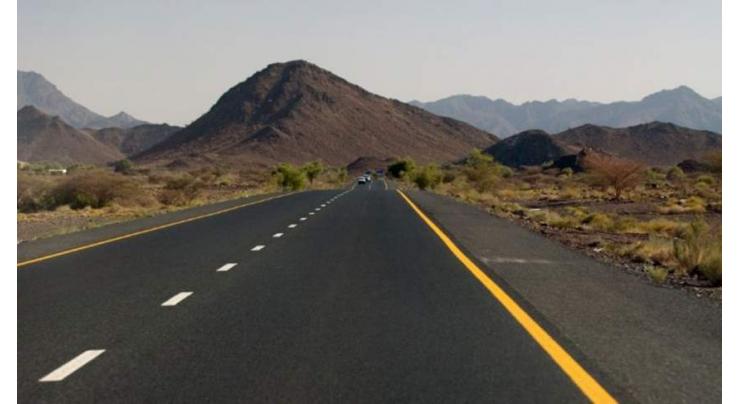
Hakla-D I Khan Motorway Likely To Become Operational By Year End
Muhammad Irfan Published April 17, 2019 | 04:25 PM

The under-construction Hakla-DI Khan Motorway project, part of western alignment of the China-Pakistan Economic Corridor (CPEC), is likely to be completed by end of this year
ISLAMABAD, (UrduPoint / Pakistan Point News - 17th Apr, 2019 ) :The under-construction Hakla-DI Khan Motorway project, part of western alignment of the China-Pakistan Economic Corridor (CPEC), is likely to be completed by end of this year.
An official of National Highway Authority (NHA) told APP on Wednesday that the motorway would reduce travel time between Islamabad and Dera Ismail Khan and boost economic activities in less developed areas of the provinces of Punjab and Khyber Pakhtunkhwa.
The four-lane 285-kilometre north-south motorway starts from the Hakla Interchange on Peshawar-Islamabad Motorway, near Fateh Jang , and termites at Yarik near Dera Ismail Khan.
From Hakla, Fateh Jang, the motorway� extends in a southwestern direction passing the towns of Pindi Gheb, Tarap, and Mianwali. Then the route will transverse the Sindh Sagar Doab region, and cross the Indus River near Dhup Sarri village near Isa Khail before entering into Khyber Pakhtunkhwa. The motorway will continue on wards before terminating near the town of Yarik, north of Dera Ismail Khan.
For ensuring timely completion,he said, the Hakla-DI Khan Motorway had been divided into five sections including Yarik-Rehmani Khail section,Rehmani Khail-Kot Belian section, Kot Belian-Tarap section,Tarap-Pindi Gheb section and Pindi Gheb-Hakla Interchange section.
He said that the motorway includes 11 interchanges, 19 flyovers (6 lanes), 15 bridges (4 lane), 74 underpasses, 259 culverts,and three major bridges (6 lane); one at River Sawan, one at River Indus and third at River Koram.
The expressway will have a 100m wide right of way in order to widen the four lane road to six lanes in future.
�He said that work on the 55 kilometer Yarik-Rehmanikhel section awarded to M/s NLC,started in October 2016 and it is scheduled to be accomplished by mid-May this year.
The cost of the project funded by Public Sector Development Programme (PSDP), is Rs 12,758 million and so far over 77 per cent physical progress has been achieved.
He sadi that� about 60 km Package-II of the motorway namely�Rehmanikhel-Kot Belian package�which had been awarded to M/s SKB-KNK JV had further been divided in four sections. Work on its first section started in January 2017 and is expected to be completed by June this year. The section costing Rs 9232 million has achieved about 55 per cent physical progress. �Its second section costing Rs 7250 million has so far achieved over 70 per cent progress. Work on the third section of the Package-II started in July 2017 and is expected to be completed by December this year.
The section would cost Rs 7137.85� �million and so far over 30 per physical progress has been achieved.
� � Section four of Rehmanikhel-Kot Belian Package would cost Rs 4441.77 million million and so far about over 87 � per cent progress has been achieved. Work on the section started in July 2017 and is expected to be completed by October this year.
The NHA official said that Package �III of the motorway, 55-kilometre Kot Belian-Tarap section has been awarded to M/s FWO. The package will cost Rs 20628.94 million and so far over 47 per cent physical progress has been achieved. Work on the package, he said, started in October 2016 and is likely to be scheduled to be completed by end of June this year but it is likely to delay.
He said that the 62 kilometre� Tarap-Pindi Gheb section had been awarded to M/s Limak-ZKB JV and the section would cost 21386.22 million. Its work started in November 2016 while its completion date is end of September. So far 48 per cent physical progress of the package has been achieved.
He said that the 63-km Package-V� Pindi Gheb-Hakla Interchange section costing Rs 16886.80 million had been awarded to M/s Limak-ZKB JV. Work on the package started in January 2017 and was scheduled to be completed by end of January this year but so far less than 40 per cent physical progress could be achieved.
/395
Related Topics
Recent Stories

Punjab CM inaugurates Pakistan’s first Virtual Women Police Station

Dutch model Donny Roelvink embraces Islam

Experts raise concerns over introduction of 10-stick packs

Iranian president arrives in Karachi

Law Minister expresses Govt's resolve to address issue of missing persons

Rizwan’s batting order may be changed: Sources

Nawaz Sharif to visit Guangzhou exhibition in China

FM Dar not traveling to China: Foreign Office

PM takes notice of deliberate delay in tax cases

Iranian President visits Allama Iqbal’s mausoleum

Iranian President arrives in Lahore today

Currency Rate In Pakistan - Dollar, Euro, Pound, Riyal Rates On 23 April 2024
More Stories From Pakistan
-
Iranian President reiterates commitment to promote bilateral relation with Pakistan
18 minutes ago -
KP CM chairs meeting of Integrated Security Architecture’s apex committee
1 hour ago -
President Raisi accorded warm welcome on arrival in Karachi
1 hour ago -
Spending quality time in nature may lower heart disease, diabetes risk: Study
1 hour ago -
President Raisi pays respects at Quaid's mausoleum
2 hours ago -
FM Dar speaks to overseas Pakistanis via Zoom
2 hours ago
-
Govt to form parliamentary committee to end violence in Balochistan: CM Bugti
2 hours ago -
LESCO collects over Rs 4.48m from 104 defaulters in 24 hours
2 hours ago -
Dr. Jamileh calls for role of Muslim women for promotion of Islamic culture
2 hours ago -
LESCO detects 73,722 power pilferers in 217 days
2 hours ago -
Farmers express concerns on low wheat price in market
2 hours ago -
CEO SEPCO for taking action against those involve in over billing & power theft
2 hours ago